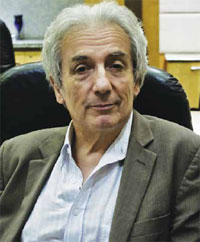|
by Stacy Oon

i: You were awarded the 2007 Nobel Prize in Physics for your discovery of the Giant Magnetoresistance (GMR) effect. How would you explain the phenomenon of spintronics and GMR to the general public?
Fert: In spintronics, there’s the word “spin”. This “spin” can be described as the small magnet carried by the electrons. Spintronics is a new type of electronics exploiting not just the charge of the electrons, but also the spin of the electrons. The first effect of spintronics to be discovered was GMR.
GMR is obtained in an artificial magnetic material — that is, films made by stacking extremely thin layers of alternating magnetic and non-magnetic materials, e.g. iron and chromium. This film is normally poorly conductive of current, but in the presence of a magnetic field the material becomes very conductive and exhibits a huge change in electrical resistance (i.e. magnetoresistance). In a hard disk’s read head, the GMR is used to detect the magnetic field created by the magnetic bits and the head can read the stored information in this way. Due to the sensitivity of the GMR, it has been possible to detect smaller fields and smaller bits, and subsequently, to put more bits and information in the same area within the same disk. Due to the GMR, information density has been multiplied by a thousand between 1996 and today.
Now, other spintronics effects have also been found for other applications, for example, new types of magnetic memory called M-RAM.
i: What effects have the findings of spintronics had so far in the development of computing devices today?
Fert: First, GMR has led to an increase in capacity of the disk, and to the extension of hard disk technology to mobile electronics, like iPods, cameras, and mobile phones. Other aspects of spintronics, namely, Tunneling Magnetoresistance (TMR) and spin transfer, will be applied to a new type of memory, called M-RAM.
In 2006, Motorola introduced the first generation M-RAM to the market, but so far it has only been used in avionics, space technology, and defense. The next generation of M-RAM, the Spin Transfer Torque RAM (STT-RAM), will appear after one or two years and will probably have a stronger impact on computer technology.
The advantage of M-RAM is its non-volatility. It doesn’t require electrical power to retain its memory, in contrast with the RAMs of today. This new RAM technology will not only reduce the electrical consumption of computers but also enable rapid start-up.
i: What further developments can you foresee for the next 10-20 years?
Fert: An important challenge for the ICTs (information communication technology) and electronics is to prepare the relay of the semiconductors after reaching the limits of today’s silicon electronics. Until now, the size of silicon electronic components has decreased continuously, with a simultaneous increase in speed. However, this continuous progress will surely stop after 10-15 years. Hence, the electronic industry has to prepare new technologies that will allow us to go beyond the limits of silicon electronics. This is a big challenge. One knows it will be possible with molecular electronics, spintronics, graphene (a carbon allotrope), etc. In the future, the size of electronic components can conceivably shrink to less than 10 nanometers.
i: What do you think about the current pace of development of consumer electronic products? How are market forces affecting the speed of technological advancement?
Fert: There is a greater need of communication devices, such as more flexible smartphones, etc. Although the market is speeding up research, in research we always have short-term objectives related to the market, as well as long-term objectives to prepare for future technologies. Today, I’m not only preparing for next years, but also the technology of the next decades.
i: Aside from GMR, what do you consider are your most sig-nificant contributions in science?
Fert: One of my important contributions was the results of fundamental physics on the interactions between electrical conduction and magnetism, which led to the discovery of the GMR. After the GMR, I guess I had important contributions in the development of the research on TMR, spin transfer, and more generally, on the understanding of spin transport.
i: What is your current research focused on?
Fert: Today, I’m working on several topics: spin transfer oscillators, spintronics with carbon nanotubes and graphene, and spin hall effect.
i: Do you have an ultimate goal in your research?
Fert: Research is an exploration involving constant surprise. It’s impossible to define an ultimate goal in advance, as we are always finding something new.
i: Has your life changed after receiving the Nobel Prize? If so, how?
Fert: Yes. Now I have new responsibilities in the organization of the research in my country, and also the responsibility of motivating young people, attending meetings, speaking with journalists, etc. I try to set aside enough time for my personal research.
i: What is your opinion on Singapore’s research environment?
Fert: I have found Singapore to be very active in research, and very attractive for researchers around the world.
i: Would you consider coming to Singapore to further your research if invited?
Fert: I am open to any interesting collaboration.
 Click here to download the full issue for USD 6.50 Click here to download the full issue for USD 6.50
|



 Click here to download the full issue for USD 6.50
Click here to download the full issue for USD 6.50